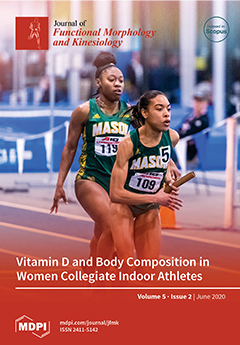We aimed to compare the effects of a personalized short-term high-intensity interval training (HIIT) vs. standard moderate intensity continuous training (MICT) on body fat percentage, abdominal circumference, BMI and maximal oxygen uptake (VO
2max) in overweight volunteers. Twenty overweight sedentary volunteers (24.9
[...] Read more.
We aimed to compare the effects of a personalized short-term high-intensity interval training (HIIT) vs. standard moderate intensity continuous training (MICT) on body fat percentage, abdominal circumference, BMI and maximal oxygen uptake (VO
2max) in overweight volunteers. Twenty overweight sedentary volunteers (24.9 ± 2.9y; BMI: 26.1 ± 1 kgm
−2) were randomly assigned to 2 groups, HIIT or MICT. HIIT trained 6 weeks (3-days/week), 40-min sessions as follows: 6-min warm-up, 20-min resistance training (RT) at 70% 1-RM, 8-min HIIT up to 90% of the predicted Maximal Heart Rate (HR
max), 6-min cool-down. MICT trained 6 weeks (3-days/week) 60-min sessions as follows: 6-min warm-up, 20-min RT at 70% 1-RM, 30-min MICT at 60–70% of the predicted HR
max, 4-min cool-down. Two-way ANOVA was performed in order to compare the efficacy of HIIT and MICT protocols, and no significant interaction between training x time was evidenced (
p > 0.05), indicating similar effects of both protocols on all parameters analyzed. Interestingly, the comparison of Δ mean percentage revealed an improvement in VO
2max (
p = 0.05) together with a positive trend in the reduction of fat mass percentage (
p = 0.06) in HIIT compared to MICT protocol. In conclusion, 6 weeks of personalized HIIT, with reduced training time (40 vs. 60 min)/session and volume of training/week, improved VO
2max and reduced fat mass percentage more effectively compared to MICT. These positive results encourage us to test this training in a larger population.
Full article






